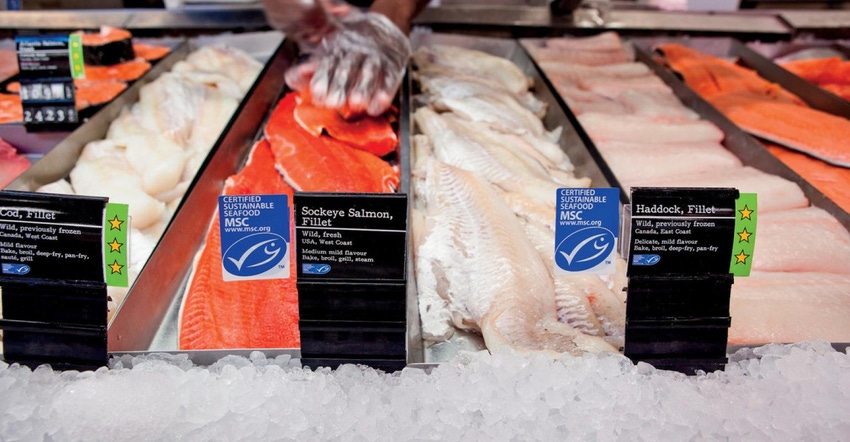Seafood sustainability top of mind for shoppers
Fish and shellfish caught in an environmentally friendly manner is an increasingly important sales driver.
November 17, 2021

An expanding base of environmentally conscious consumers is changing the face of seafood merchandising.
With sustainability top of mind for many shoppers, it is becoming increasingly important for retailers to spotlight their suppliers’ eco practices if they are to sustain or grow category activity, analysts note.
Studies in early 2020 by GlobeScan, a Toronto-based independent research and strategy consultancy, for instance, revealed that 58% of North American seafood consumers agree that it is necessary to consume fish and shellfish only from sustainable sources to protect the ocean. In addition, 48% of North American shoppers are willing to pay more for seafood from a certified sustainable fishery.
In a ranking of seafood purchase motivators, sustainably sourced and environmentally friendly rose from being the 10th top purchase driver to sixth from 2018 to 2020, trailing only safe to eat; fresh; taste; health; and price, GlobeScan reports. Sustainably sourced and environmentally friendly also is the main sustainability-focused motivator, followed by non-genetically modified and caught in the wild.
In addition, North American consumers list ocean health and the decline of fish populations as their third-highest environmental concern, following climate change, and pollution and waste damaging rivers and streams. The data is from a GlobeScan survey of more than 5,700 seafood shoppers from the U.S. and Canada.
“The importance of sustainable and environmentally friendly product offerings to consumers is rising around the world,” said Eric Critchlow, program director, USA, for the Marine Stewardship Council (MSC), a London-based global nonprofit organization that works to end overfishing. “The pandemic has only intensified the desire for sustainable options and consumers are demanding that retailers and brands offer products that align with their values.”
He noted that many shoppers are seeking “clear and easy ways” to support sustainable food producers without having to be scientists or harvesters themselves. “They're looking for ‘win-win’ products that are both healthy for them and the ocean,” Critchlow said.
Spotlight on sustainability
By offering sustainable selections and attaching ecolabels to packaging and spotlighting their commitment to sustainability via in-store signage, supermarkets can also attract consumers “who are looking to support the environment, but don't know how,” Critchlow said. Ecolabels are attractive to shoppers because they are a quick and simple way to verify an environmentally sustainable decision at the point of purchase, he noted.
Yet, despite consumers’ strong interest in sustainable practices, uncertainty about the meaning of “sustainable” as it relates to specific products is also creating an “intent versus action gap,” Critchlow said.
“There are too many confusing messages about sustainability that consumers receive, and many are unsubstantiated," he noted. “‘Sustainability’ has become a marketing buzzword and retailers have the challenge of helping consumers navigate a cluttered landscape and greenwashing.”

Sixty-six percent of North Americans, meanwhile, believe retailers’ and brands’ claims about sustainability and the environment need to be clearly labeled by an independent organization, GlobeScan notes.
Indeed, Critchlow said some products in the seafood supply chain carry false environmental and sustainability claims and it can be challenging for supermarkets to discern what claims and labels are reputable. As a result, it is vital for retailers to research and understand the source of their seafood, he said, noting that partnering with a trusted organization can make it easier to navigate the process.
“Unless sustainability claims are verified by third-party organizations, it is challenging to know the validity of these claims, especially without independent checks and balances along the supply chain,” Critchlow said.
Driving change
Supermarkets also can help drive change by engaging their supply chains in sustainability efforts and by shaping customer shopping choices, said Kathryn Novak, global markets director for Sustainable Fisheries Partnership, a Honolulu-based nonprofit organization that operates globally to rebuild depleted fish stocks, reduce the environmental and social impacts of fishing and fish farming, and advance opportunities for fishing communities.
That is important as switching to a different brand or product is the top action seafood consumers are willing to take to help the ocean, GlobeScan reports.
When spotlighting a seafood product’s sustainable attributes, it is important that retailers make the information accessible and easy to understand, Novak said. Eighty-eight percent of consumers, for instance, agree that they want better information so they can be confident that they are not buying unsustainable fish or seafood products, GlobeScan states.
“The most impactful choice customers can make is to buy seafood from retailers that are supporting fisheries’ improvements worldwide,” Novak said, adding that because the U.S. and Europe are two of the largest buyers and importers of seafood globally, “retailers have tremendous leverage to demand improvements in seafood sourcing. Even small local retailers can make a difference by sourcing from suppliers that are leading improvement efforts.”

About the Author(s)
You May Also Like




